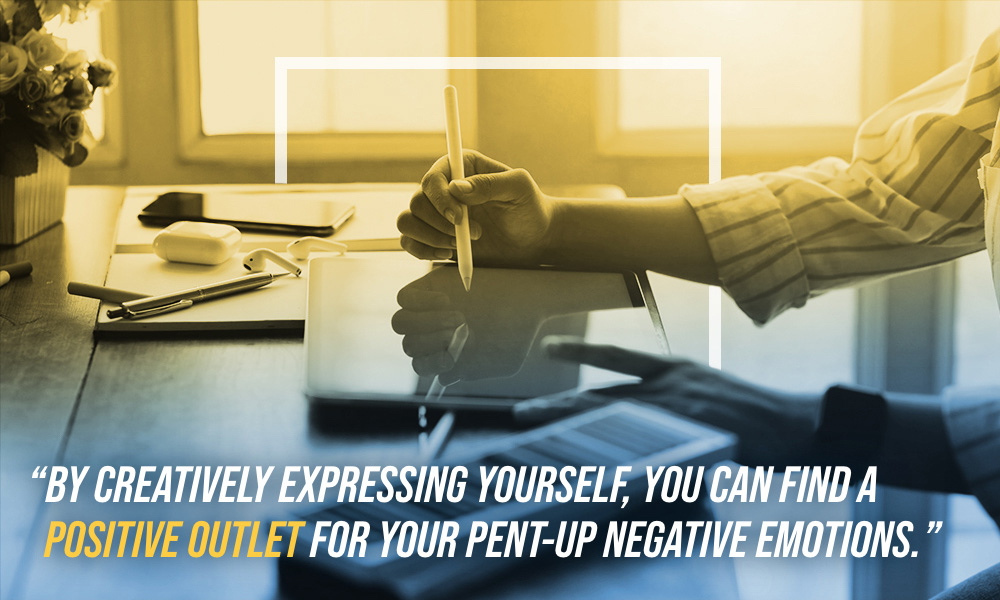Endless traffic, rude remarks from co-workers, arguments with your loved ones—any one of these things can ignite an anger fuse. It’s not uncommon to try and bury that fuse in hopes of extinguishing pent-up anger. But if you’re not careful, buried emotions can explode when you least expect them to, destroying personal and professional relationships.
Of course, anger is a typical stress response. It’s a natural warning telling us that we’re experiencing something that we’d rather not experience. But when you don’t know how to let go of anger, it can become destructive.
By keeping anger bottled up inside, you risk becoming consumed by it, lashing out unexpectedly and losing your ability to think clearly. For your own physical and mental well-being, it’s vital you learn how to let go of anger.
First, consider where your angry feelings are stemming from and how they’re affecting you. Then, take a look at our 20 tips for letting go of anger.
Where Are Your Angry Feelings Coming From?
If you start the day feeling ticked off, it won’t take much to reignite your fuse. Or if you have a stressful day at work, it’s common to come home feeling agitated. In either scenario, you may find that the smallest thing can make you angry. To let go, release and relieve pent-up anger, you must identify where your angry feelings stem from.
Maybe you recently argued with a family member over something trivial, like who would be responsible for taking a loved one to their doctor’s appointment. Or perhaps a coworker shot down your latest business development idea, sparking your anger. Now ask yourself: Was that instance worth losing a whole day—or multiple days—to anger?
Consider whether the energy you’re putting into the anger is worth it in the first place. Who ignited your anger? Was it a close friend you respect, or was it someone you’ll never see again, like a driver in traffic or a grocery clerk? You won’t want to lose a trusted friend, but a passerby in rush hour traffic is simply a blip in history, and they don’t deserve your energy.
Why Letting Go of Anger is Essential to Your Well-Being
You don’t have to earn a Ph.D. to know that holding onto feelings of anger is detrimental to both your mental health and physical health. Negative emotions like anger affect everything from your blood pressure to your bone density, wreaking havoc throughout your body. And when you get angry, your body produces more cortisol, a hormone that heightens your stress levels and sparks a fight-or-flight response.
The more cortisol your body has, the less serotonin—or happy hormone—your body makes. With more focus on negative feelings, your body will…
- Increase your heart rate, blood pressure and blood sugar
- Decrease the power and effectiveness of your immune system
- Increase the likelihood of painful migraines and headaches
Not to mention, anger is also harmful to overall emotional and mental wellness. With happy hormones replaced by stress hormones, you’re more likely to feel a dip in your self-esteem and overall confidence. This can make it difficult to maintain a high level of self-awareness, meaning an awkward, angry eruption at work or home can occur at any time.

20 Tips on How to Let Go of Anger
In addition to ruining your positive mindset for the day, anger can negatively impact every aspect of your well-being. That’s why you must learn how to relieve pent-up anger and gain peace of mind once and for all. If you’re having trouble letting go of angry feelings, consider these 20 tips for when anger rears its ugly head.
1. Own Your Anger
You cannot control your anger until you acknowledge it. By doing so, you learn how to own it before it owns you. To do this, you need to accept the emotion. Accept that in this very moment, you feel wronged by someone or something. Then, remind yourself that you are strong enough to control that emotion, and put it behind you.
Remember that you can choose between making your anger worse (like feeding into it) or making it disappear. In other words, angry feelings will only get as bad as you allow them to. It’s up to you to own your anger and address it, so you can move on. Plus, by owning your anger, you put yourself in a position to harness it for good. Anger can be a massive catalyst for positive change, so long as you own it and channel it into something productive.
2. Practice a Mindfulness Technique
Mindfulness techniques encompass everything from conscious journaling to meditation. Both can help you learn how to alleviate anger, but meditation, in particular, can be useful for releasing it. Case in point: body scan meditation.
Body scan meditation is a mindfulness technique in which you hone in on where negative emotions (such as pent-up anger) have nestled in your body. Then, you focus on releasing those negative feelings. To begin, get comfortable. Lie down if you can, especially if you’re doing your body scan before going to sleep.
After you get cozy, take a few deep breaths and bring your attention to your feet. Do you feel any pain or tension there? When you focus on the pain, do any thoughts or emotions accompany it? Acknowledge these feelings and gently breathe into them. Then, breathe through them. Continue up to your ankles and knees, breathing through the tension. Visualize the negativity leaving your body through your breath and disappearing into the air around you.
Continue this practice with each area of your body, gradually moving up from your legs until you reach the top of your head. Notice where you’re holding your anger. Which areas feel hot or tingly? What are you thinking about as you feel that sensation? Wherever there is tightness, pain or pressure, breathe into it. Not only can this practice help release the anger you’ve stored there, but you can become more aware of any hiding places for future mindfulness scans.
3. Adopt Deep Breathing
In the heat of the moment, it’s easy to overlook something like your breathing. However, those shallow, fast breaths you take when you’re angry will only keep your body in fight-or-flight mode. Instead of calming down, you’ll stay defensive. To combat this, try taking slow, controlled deep breaths.
Deep breathing is a relaxation technique taught in anger management programs. It helps individuals learn how to let go of anger and calm down. Inhale deeply through your nose and exhale slowly through your mouth. Breathe in from your belly rather than your chest, paying attention to the way your stomach softly rises and falls in response. Try doing this exercise 3 times a day for 5 to 10 minutes as a preventative measure. Or do it as needed to help your body relax in the face of anger.
4. Walk to Clear Your Mind
In the moments you feel anger building up inside you, take a moment for a quick walk. If you’re at home or at your desk, try going outside for some fresh air. If you’re talking to someone and you feel anger surfacing, simply excuse yourself for a moment alone. Give yourself permission to walk away, and take a few minutes to gather your thoughts and release negative emotions.

A lot of people say things they don’t mean when they’re mad. Take this time to cool off and think about how you’d like to respond before saying something you might regret down the line. After you successfully calm down, consider your response. Chances are, you’re going to like your calm response a lot more than your angry one.
5. Engage in Physical Exercise
One of the most effective ways to reduce anger is to exercise daily. You might roll your eyes a bit at this one, but get this: Exercise actually reduces levels of your body’s stress hormones. Plus, it increases your endorphins—happy hormones that can naturally make you feel better.
Physical exercise can also be an outlet for your negative emotions. Physical activities, like running and jogging, give you a chance to let go of the hurt or disappointment you’ve been holding onto. More active programs, like Zumba and boxing, allow you to kick, punch and shimmy those negative feelings right out of your body. No matter how you exercise, getting up and getting active is sure to help release pent-up anger.
6. Take a Timeout from Social Media
Social media is fun for mindless scrolling, funny memes and connecting with friends and family. But sometimes, social media projects an unrealistic ideal of how people look, act and carry themselves. When you’re feeling angry, it doesn’t pay to compare yourself to picture-perfect lives (that definitely aren’t like that in real life).
Not to mention, burying your nose in your phone provides another excuse to bottle your emotions. Instead, take a timeout from social media to address whatever is currently bothering you.
7. Visualize Something Positive
If anger continues to rear its head, try replacing your negative thoughts with ideas that make you feel at ease. When tensions rise, paint a mental picture that takes you out of the heat of the moment and into your happy place.
Think of any place—real or imaginary—that makes you feel good and safe. It can be a hike you took through the woods last year or a white sand beach you dream of visiting someday. Whatever it is, focus on the sensory details by imagining yourself there.
What can you smell? What sounds surround you? Use these details to immerse yourself in your happy place. Be aware of your breathing, and keep this image in your mind until you feel your anger start to fade. Returning to your happy place in the midst of your next argument or work setback can help you feel more relaxed and keep you in a positive mindset.
8. Talk to a Friend
Angry outbursts probably won’t do you any favors with your loved ones or colleagues, but that doesn’t mean you can’t talk through your frustrations with a trusted friend or family member. After a particularly rough day, it can be nice to vent about the bad things that happened. The best thing about friendships is that you can make it through the bad times together.

If anger has been welling up inside of you, a good venting session with a trusted friend can be just what you need. Plus, allowing yourself space to express some of your anger prevents it from bubbling up and taking over your emotions.
9. Identify Workable Solutions
Instead of vowing to stay angry, why not do something about it? Rather than focusing on how angry you are, focus your attention on finding a workable solution to the things that made you angry in the first place. What needs to change? Who can you speak with to kickstart that change?
In this same thought, take the time to consider if there are any workable solutions or if the moment is out of your control—kind of like when someone you’ll never see again is the source of your anger. If someone cut you off in traffic and sped into an exit lane, will you follow them just to shout?
Now and again, there will be things that you cannot change, and you will have to accept that. You only have so much energy to give. By focusing on what you can control, you can use your limited energy effectively and avoid becoming aggravated by situations you cannot control.
10. Initiate a Productive Conversation
So, you probably won’t have a productive conversation with the guy that cut you off in traffic. But those you can have productive conversations with are those closest to you, who probably feel the effects of your anger more regularly. If a coworker or family member keeps ticking you off, get to the heart of that anger and find workable solutions together.
This tip is especially important to gain a better perspective on your anger. Angry feelings can warp your perception of reality, making it feel like the world (and everyone in it) is out to get you. The next time anger starts bubbling to the surface, start a conversation with the other person to check your perspective.
You may have thought you’d found a workable solution, but without seeing the other person’s point of view, you may find yourself in hot water again soon. Share your thoughts with the other person, and let them shine a light on their perspective. Together, you can have a productive conversation that alleviates pent-up anger.
11. Find an Outlet for Your Emotions
Anger is a very strong emotion. It can cloud your judgment and drown out any other emotions you’re also feeling. It’s important to find an outlet for all of your emotions so you can work through the strongest ones.
Journaling is an easy and convenient way to navigate your emotions. It can really help you as you learn how to let go of anger. Through a journal, you can process your thoughts thoroughly and carefully. You can identify where your anger is stemming from and how you respond to it, which can increase your self-awareness and prevent future flare-ups.
If you’re into drawing or painting, you can also express your emotions that way. Just grab some paint and pens, and illustrate what your anger looks like to you. By creatively expressing yourself, you can find a positive outlet for your pent-up negative emotions.

12. Use a Stress Relief Tool
Physical activity is great for reducing anger, but if you get frustrated while you’re in the office, you can’t exactly break into a jog. If you find that you need to physically release your anger, use a stress-relief tool instead. Consider items like stress balls, small punching bags and other fidget-like gadgets you can keep at your desk or in your car. You can use them as preventative measures or in the heat of the moment to calm you down.
But bear in mind, stress-relief tools are mere bandaids. They help you reduce your anger, but they don’t help you work through it or let it go. It’s best to funnel your angry energy into something productive, like finding a solution. This way, you can reduce your feelings of anger and potentially prevent a future mishap rather than throwing a bandaid on the bigger problem.
13. Defuse Anger with Laughter
The best way to keep a balanced perspective in the face of anger is to find the humor in a heated moment. Of course, this doesn’t mean you should simply laugh off your problems or laugh at the person causing your anger. Rather, you should try to look at these rage-inducing moments through a more lighthearted lens.
The next time you feel those prickles of anger beginning, imagine what the situation would look like to an outsider. Would they be amused or angry? How would a kindergartener react? Though we advise against sticking your tongue out and stomping around, chances are, a 5-year-old would react a bit lighter than you would.
By not taking yourself as seriously in these heated moments, you have the opportunity to see how insignificant minor annoyances are in the grand scheme of things. And by welcoming laughter and positive vibes, you’re more likely to attract positivity instead of negative feelings, like anger or disappointment.
14. Change Your Environment
Are your immediate surroundings the main cause of your anger? Is your current environment weighing you down or making you feel trapped? For example, being stuck at home during the COVID-19 pandemic contributed to feelings of stress for many. Even in an area as bustling as New York City, the quiet and stillness of remaining indoors can allow pent-up anger to spill out.
Likewise, assess if your routine is contributing to your anger. For instance, a hectic morning trying to get everyone dressed, fed and out of the door might heighten angry feelings. In this case, the situation is controllable. You can lighten your load in the morning by preparing things the night before, setting to-do’s out for family members or even waking up earlier.
15. Identify and Avoid Triggers
When letting go of anger for good, you must understand the things that trigger your irritation in the first place. Aggravated by a colleague that always taps their foot? Bring noise-canceling headphones to work. Frustrated by your morning commute? Look into alternative routes.
Once you become aware of the triggers for your anger, you can take the necessary steps to avoid them. If you’re not sure where your anger is coming from, try to pause the next time you start to feel irritated.
Identify what was happening in the moments leading up to your anger. Were you with someone specific? Were you doing a certain activity? Pinpoint what’s causing your anger and avoid the moments, places or people that make it spike.
16. Take Responsibility
At the end of the day, the only person living with your anger is you. If you constantly have feelings of anger, will you take responsibility for defeating them?
The reality is that despite other’s actions, you and you alone are responsible for what happens in your life, including how you react to stressful situations. You are responsible for your happiness or unhappiness. Remember this when you decide whether or not you allow anger to remain pent up inside.
Own your anger, become responsible for your emotions and watch how much easier it is to navigate negative feelings when you’re not shifting the blame.
17. Don’t Let Everything Light Your Fuse
From bad drivers to spilled milk, sometimes we let the smallest things light our fuse. Once that anger gets started, it can be difficult to diffuse it. But most of the time, what makes us angry are minor inconveniences that we cannot control.
Not every event deserves a reaction. The next time you find yourself boiling over with anger, remember that you’re allowing the situation to cause those angry feelings. Your happiness largely depends on your ability to let the small things go. If it’s not important, don’t let it get you fired up.
18. Focus on the Good
It’s only natural to dwell on the things that upset you or make you angry. Unfortunately, that energy spent focusing on the bad things won’t benefit your physical or mental health. Instead, focus on the good things. What part of the day made you smile? What are you excited to do tomorrow?

For the days when it’s hard to find the silver lining, focus on what you’re grateful for instead. Consider everything you’re thankful for in your life. This practice can help put your anger into perspective and relieve the unnecessary baggage you’re carrying.
19. Don’t Hold Grudges
In the process of learning how to let go of anger, you must also learn how to let go of grudges. Realistically, holding grudges affects you more than the person you’re holding the grudge against. That person doesn’t live inside your head, you do—so who is the grudge really hurting?
Grudges not only consume your limited energy, but they also make your emotional state toxic. They can taint other positive emotions, like happiness, love and laughter. Next time you get angry at another person, remember that anger will impact you in the long-term, not them.
20. Practice Forgiveness
Last but not least, when letting go of anger, learn to practice forgiveness. Forgiveness is taking an active stance to release feelings of resentment, revenge and hatred. When you make a conscious effort to relieve these feelings, your anger will subside as well. After all, what remains once you release those pent-up negative feelings towards the situation?
To be clear, forgiveness doesn’t mean that the sting of the situation will automatically fade away. But when you forgive, you’re taking that step for your own sake—to regain control over your emotions and move on. When you learn to forgive, you learn to let go of your anger.
Now is the Time to Relieve Pent-Up Anger
It is perfectly normal to feel angry from time to time. But if you’re not careful, angry feelings can creep into your everyday life, causing rifts in friendships, family, and your career. Letting go of anger isn’t always easy, but it’s always worth it. And once you learn how to let go of anger, you can experience true peace of mind. By following these 20 tips, you can learn to let go, release, and relieve the pent-up anger that’s holding you back.







5 Responses